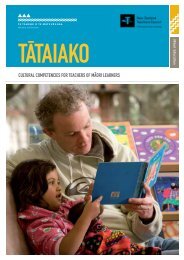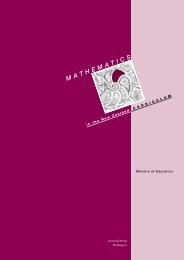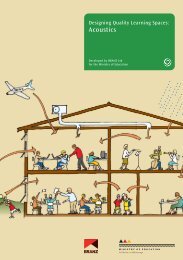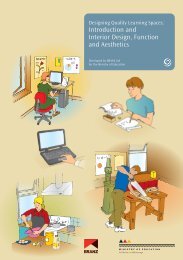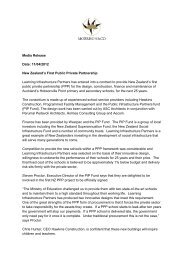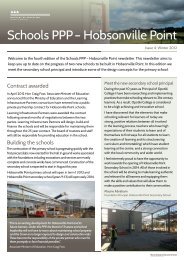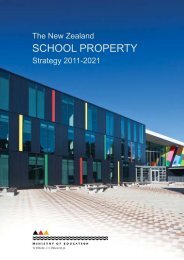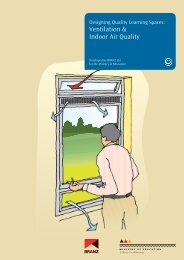values in the new zealand curriculum - Ministry of Education
values in the new zealand curriculum - Ministry of Education
values in the new zealand curriculum - Ministry of Education
You also want an ePaper? Increase the reach of your titles
YUMPU automatically turns print PDFs into web optimized ePapers that Google loves.
(AIMHI) project, which Hawk and Hill have <strong>in</strong>dependently exam<strong>in</strong>ed. In both <strong>the</strong> study and<br />
<strong>the</strong> project, <strong>the</strong> concern was to exam<strong>in</strong>e and develop strategies that mediate conflict<strong>in</strong>g<br />
<strong>values</strong> that may arise between family/aiga, church, peer groups, and <strong>the</strong> world <strong>of</strong> work,<br />
and <strong>the</strong> school<strong>in</strong>g context <strong>of</strong> Pacifica students (Coxon et al., 2002, p. 82). It was<br />
suggested that a first step to address<strong>in</strong>g this gap, would be to ensure that <strong>the</strong>re were more<br />
Pacific Island teachers with<strong>in</strong> schools. Pasikale (1999) also argues that all teachers must<br />
first value empathy when address<strong>in</strong>g <strong>the</strong> <strong>in</strong>dividual learn<strong>in</strong>g needs <strong>of</strong> Pacific students <strong>in</strong><br />
order to develop appropriate learn<strong>in</strong>g experiences for all. In particular, empathy should be<br />
used to check teachers’ use <strong>of</strong> categorical or one-dimensional def<strong>in</strong>itions <strong>of</strong> Pacific<br />
learners (cited <strong>in</strong> Coxon et al., 2002). Vaioleti (2001) argues that Pacifica students’ value<br />
this affective approach to learn<strong>in</strong>g, where students will first evaluate whe<strong>the</strong>r <strong>the</strong> teacher<br />
likes <strong>the</strong>m, and secondly, whe<strong>the</strong>r <strong>the</strong> classroom learn<strong>in</strong>g has relevance to <strong>the</strong>ir lives.<br />
Part <strong>of</strong> this empathy and relevance is communicated through <strong>the</strong> role that <strong>the</strong> teacher<br />
takes as “model, guide and expert” (p. 8). The tuakana/te<strong>in</strong>a relation is more likely to be<br />
supported by <strong>the</strong>se ways <strong>of</strong> relat<strong>in</strong>g.<br />
Language and culture toge<strong>the</strong>r communicate knowledge. In most New Zealand schools,<br />
English rema<strong>in</strong>s <strong>the</strong> dom<strong>in</strong>ant language <strong>of</strong> learn<strong>in</strong>g. In Anae’s (2001) study with second<br />
generation Samoan, most could not use <strong>the</strong>ir language, but most could understand it.<br />
Language was regarded as an assignation <strong>of</strong> Samoan identity and/or fia palagi<br />
accusations. However, most reported that <strong>the</strong> most important aspect <strong>of</strong> culture was be<strong>in</strong>g<br />
able to communicate through beliefs, <strong>values</strong> and ways <strong>of</strong> do<strong>in</strong>g th<strong>in</strong>gs as New Zealandborn<br />
Samoan. For <strong>the</strong> Cook Island Māori born <strong>in</strong> New Zealand (Underhill-Sem and<br />
Fitzgerald, 1996), 43% (<strong>of</strong> a small sample <strong>of</strong> 50) reported that <strong>the</strong>y could speak <strong>the</strong><br />
language with various levels <strong>of</strong> fluency, but most reported that <strong>the</strong>y did not speak Cook<br />
Island Māori. While most spoke English at home, <strong>the</strong> Cook Island Māori language was<br />
spoken when engaged <strong>in</strong> specific contexts, particularly at Church. Churches are important<br />
places where many Pacifica peoples not only hear <strong>the</strong>ir languages spoken, but f<strong>in</strong>d <strong>the</strong>ir<br />
cultural <strong>values</strong> spoken and alive with<strong>in</strong> <strong>the</strong>ir Church communities with<strong>in</strong> Aotearoa, and <strong>in</strong><br />
relation to <strong>the</strong>ir connections through genealogy and to <strong>the</strong> homeland.<br />
Values are communicated (<strong>in</strong> part) through language and constitute culture. The Palagi<br />
educational system privileges many <strong>in</strong>dividualised <strong>values</strong>. In most Palagi classrooms, <strong>the</strong><br />
written language dom<strong>in</strong>ates both with<strong>in</strong> <strong>the</strong> classroom, <strong>in</strong> what is produced for<br />
Values <strong>in</strong> <strong>the</strong> New Zealand Curriculum: A Literature Review 41



